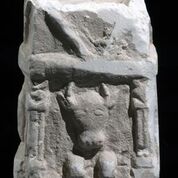Ancient Palace Unearthed in Lachish Region
Jerusalem, 30 November, 2017 (TPS) -- Archaeologists from the Hebrew University and the Israel Antiquities Authority announced the discovery of a 2,200-year-old structure, possibly an Idumean palace or temple, adorned with an image of a bull, the Antiquities Authority said Thursday.
The structure, which was unearthed in October, probably dates from the Hellenic period. It was uncovered at the site of Horvat ‘Amuda, situated in the heart of a military training area in the Lachish region, near the Beit Guvrin archeological site. The IAA said in a statement that the Horvat ‘Amuda was apparently an agricultural satellite of Maresha, which served as the Idumean district capital (today it is part of Bet Guvrin-Maresha National Park).
Prior to that, during the fifth century BCE (the Persian period), the Idumeans – a Semitic people that originated in southern Jordan – had settled in the Judean foothills, remaining there for several centuries. After the area was conquered by the Hasmoneans in 112 BCE, several decades after the story of Chanukah took place; the Idumeans converted and subsequently blended into the Judean population.
The discoveries were astounding. Two stone incense altars were discovered in one of the rooms of the structure; one of them bears the carved image of a bull, standing in what is apparently the façade of a temple adorned with magnificent columns.
Excavation directors Dr. Oren Gutfeld of the Hebrew University and Pablo Betzer and Michal Haber of the Israel Antiquities Authority said the altar is a unique and rare find in terms of its decoration.
“Similar structures in this country can be counted on the fingers of one hand. It seems that the building was intentionally dismantled, possibly during the Hasmonean conquest of the region.” they said.” The bull may have symbolized a deity worshipped by the Idumeans.”
In addition to the incense altar, archeologists also unearthed delicate pottery vessels, including painted bowls, juglets and oil lamps, numerous underground spaces that would have been used as quarries or for ritual baths (mikvaot), oil presses and dovecotes. Hiding tunnels from the time of the Jewish war against the Romans were also discovered during the excavations; one contained an intact pot from the time of the Bar Kokhba Revolt (132–135 CE).
The site was discovered with the help of camera-equipped drones, a technology that
has become an increasingly important part of the archaeologists’ toolbox in recent years. As part of an extensive archaeological research project of the area between Bet Guvrin and Maresha in the north and Moshav Amatzia in the south, the drone cameras photographed the archaeological remains from above, revealing hints of the discovered structure.
“The technology helped us to choose where to focus our excavation probes, and, indeed, it very quickly emerged that this was, in fact, a unique discovery. We hope that our continued excavation of the site in the spring will uncover more of the story told here,” said the archeologists.
The excavation, which was funded jointly by the Beit Lehi Foundation and the Israel Antiquities Authority, was carried out with the participation of archaeology students from the Hebrew University, Bar-Ilan University, as well as a group of volunteers from the United States.


